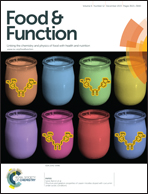Structure and gelation properties of casein micelles doped with curcumin under acidic conditions
Abstract
In this study, the ability of micellar casein (MC) to interact with curcumin during acidification and to produce acid gel was investigated. Steady-state fluorescence spectroscopy of curcumin variation and fluorescence quenching of caseins upon binding with curcumin molecules were evidenced. Increasing the temperature from 20 to 35 °C enhanced MC–curcumin interactions as reflected by the increase in the binding constant from 0.6 ± 0.3 × 104 to 6.6 ± 0.6 × 104 M−1. From changes in entropy, enthalpy and Gibbs free energy, hydrophobic interactions were proposed as major binding forces. Static fluorescence MC quenching was demonstrated for the MC–curcumin complex during acidification. From pH 7.4 to pH 5.0, the binding site numbers varied in the range from 1.25 ± 0.05 to 1.49 ± 0.05 and the binding constant kb varied from 3.9 ± 0.4 × 104 to 7.5 ± 0.7 × 104 M−1. Small angle X-ray scattering profiles demonstrated that the MC internal structure was unchanged upon curcumin binding. The ζ-potential value of curcumin-doped MC indicated that curcumin did not modify the global charge of MC particles. Acid gelation studied by oscillation rheology and static multiple light scattering at 20 and 35 °C led to a similar behavior for native and curcumin-doped MC suspensions. For the first time, it was demonstrated that the colloidal and functional properties of MC were unchanged when doped with curcumin during acidification.


 Please wait while we load your content...
Please wait while we load your content...